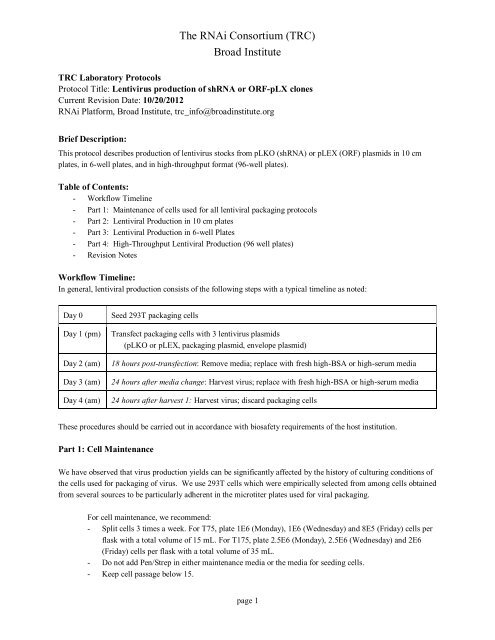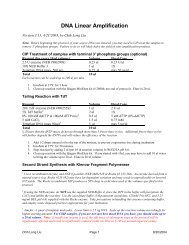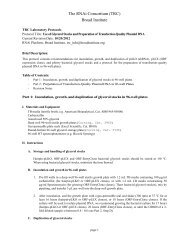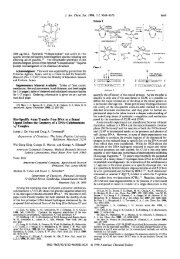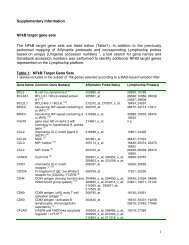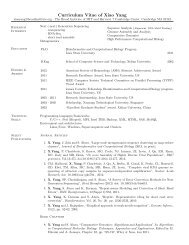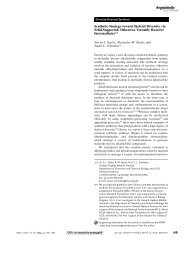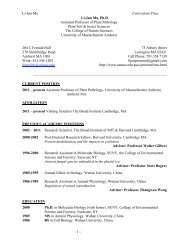The RNAi Consortium - Broad Institute
The RNAi Consortium - Broad Institute
The RNAi Consortium - Broad Institute
You also want an ePaper? Increase the reach of your titles
YUMPU automatically turns print PDFs into web optimized ePapers that Google loves.
<strong>The</strong> <strong>RNAi</strong> <strong>Consortium</strong> (TRC)<br />
<strong>Broad</strong> <strong>Institute</strong><br />
TRC Laboratory Protocols<br />
Protocol Title: Lentivirus production of shRNA or ORF-pLX clones<br />
Current Revision Date: 10/20/2012<br />
<strong>RNAi</strong> Platform, <strong>Broad</strong> <strong>Institute</strong>, trc_info@broadinstitute.org<br />
Brief Description:<br />
This protocol describes production of lentivirus stocks from pLKO (shRNA) or pLEX (ORF) plasmids in 10 cm<br />
plates, in 6-well plates, and in high-throughput format (96-well plates).<br />
Table of Contents:<br />
- Workflow Timeline<br />
- Part 1: Maintenance of cells used for all lentiviral packaging protocols<br />
- Part 2: Lentiviral Production in 10 cm plates<br />
- Part 3: Lentiviral Production in 6-well Plates<br />
- Part 4: High-Throughput Lentiviral Production (96 well plates)<br />
- Revision Notes<br />
Workflow Timeline:<br />
In general, lentiviral production consists of the following steps with a typical timeline as noted:<br />
Day 0 Seed 293T packaging cells<br />
Day 1 (pm) Transfect packaging cells with 3 lentivirus plasmids<br />
(pLKO or pLEX, packaging plasmid, envelope plasmid)<br />
Day 2 (am) 18 hours post-transfection: Remove media; replace with fresh high-BSA or high-serum media<br />
Day 3 (am) 24 hours after media change: Harvest virus; replace with fresh high-BSA or high-serum media<br />
Day 4 (am) 24 hours after harvest 1: Harvest virus; discard packaging cells<br />
<strong>The</strong>se procedures should be carried out in accordance with biosafety requirements of the host institution.<br />
Part 1: Cell Maintenance<br />
We have observed that virus production yields can be significantly affected by the history of culturing conditions of<br />
the cells used for packaging of virus. We use 293T cells which were empirically selected from among cells obtained<br />
from several sources to be particularly adherent in the microtiter plates used for viral packaging.<br />
For cell maintenance, we recommend:<br />
- Split cells 3 times a week. For T75, plate 1E6 (Monday), 1E6 (Wednesday) and 8E5 (Friday) cells per<br />
flask with a total volume of 15 mL. For T175, plate 2.5E6 (Monday), 2.5E6 (Wednesday) and 2E6<br />
(Friday) cells per flask with a total volume of 35 mL.<br />
- Do not add Pen/Strep in either maintenance media or the media for seeding cells.<br />
- Keep cell passage below 15.<br />
page 1
Part 2: Lentiviral Production in 10 cm plates<br />
I. Materials<br />
<strong>The</strong> <strong>RNAi</strong> <strong>Consortium</strong> (TRC)<br />
<strong>Broad</strong> <strong>Institute</strong><br />
Transfection-quality plasmid DNA for:<br />
- pLKO/pLEX vector (TRC library plasmid – see DNA prep protocol)<br />
- 2 nd generation packaging plasmid containing gag, pol and rev genes (e.g. pCMV-dR8.91 or pCMVdR8.74psPAX2)*<br />
- envelope plasmid (e.g. VSV-G expressing plasmid, pMD2.G)*<br />
* recommended: use endotoxin-free plasmid isolation kits (Qiagen)<br />
TransIT-LT1 transfection reagent (Mirus Bio, MIR 2300/5/6)<br />
alternative: FuGENE 6 (Roche, #1 814 443 or #1 988 387)<br />
OPTI-MEM serum-free media (Invitrogen, #31985-070)<br />
293T packaging cells<br />
Cell maintenance/seeding media: Antibiotic-free 293T growth media (DMEM + ~10% iFBS + 0.1x Pen/Strep)<br />
500 mL DMEM (Dulbecco's Modification of Eagle's Medium; e.g. Mediatech #10-013-CV)<br />
50 mL iFBS (heat-inactivated Fetal Bovine Serum; e.g. HyClone #SH30071.03)<br />
Viral harvest media: High-BSA 293T growth media (DMEM + ~10% iFBS + ~1g/100mL BSA + 1x Pen/Strep)<br />
500 mL DMEM (Dulbecco's Modification of Eagle's Medium; e.g. Mediatech #10-013-CV)<br />
50 mL iFBS (heat-inactivated Fetal Bovine Serum; e.g. HyClone # SH30071.03)<br />
64 mL 10g/100mL BSA stock (microbiology-grade Bovine Serum Albumin; VWR #14230-738)<br />
5 mL 100x Pen/Strep (10,000 IU/mL penicillin, 10,000 µg/mL streptomycin; e.g. Mediatech #30-002-CI)<br />
alternative viral harvest media: High-serum 293T growth media (DMEM + 30% iFBS + 1x Pen/Strep)<br />
500 mL DMEM (Dulbecco's Modification of Eagle's Medium; e.g. Mediatech #10-013-CV)<br />
200 mL iFBS (heat-inactivated Fetal Bovine Serum; e.g. HyClone # SH30071.03)<br />
5 mL 100x Pen/Strep (10,000 IU/mL penicillin, 10,000 µg/mL streptomycin; e.g. Mediatech #30-002-CI)<br />
10 cm tissue culture plates<br />
Polypropylene storage tubes<br />
II. Instructions<br />
1. Seed 293T packaging cells at 3.8x10 5 cells/mL (10 mL per plate) in antibiotic-free growth media (DMEM<br />
+ 10% iFBS) in 10 cm tissue culture plates.<br />
2. Incubate cells for 24 hours (37 °C, 5% CO2), or until the following afternoon. After ~24 hours, the cells<br />
should be 70-80% confluent.<br />
3. Transfect packaging cells:<br />
a. Prepare a mixture of the 3 transfection plasmids:<br />
Reagent per 10 cm plate<br />
packaging plasmid (e.g. pCMV-dR8.91 or pCMV-R8.74psPAX2) 9 µg<br />
envelope plasmid (e.g. VSV-G/pMD2.G) 0.9 µg<br />
pLKO or pLEX vector 9 µg<br />
page 2
<strong>The</strong> <strong>RNAi</strong> <strong>Consortium</strong> (TRC)<br />
<strong>Broad</strong> <strong>Institute</strong><br />
OPTI-MEM to total volume 225 µL<br />
b. Dilute TransIT-LT1 transfection reagent in OPTI-MEM. Add the TransIT-LT1 reagent dropwise<br />
and mix by swirling the tip or gently flicking the tube (do not mix by pipetting or vortexing).<br />
Incubate 5 minutes at room temperature.<br />
Reagent per 10 cm plate<br />
TransIT-LT1 54 µL<br />
OPTI-MEM to total volume 90 µL<br />
c. Add the diluted TransIT-LT1 reagent to the 3 plasmid mix dropwise and mix by swirling the tip or<br />
gently flicking the tube.<br />
d. Incubate the transfection mix for 30 minutes at room temperature.<br />
e. Carefully transfer the transfection mix to the packaging cells (in antibiotic-free growth media).<br />
<strong>The</strong> packaging cells can be sensitive to perturbation - take care not to dislodge the cells from the<br />
plate.<br />
4. Incubate cells for 18 hours (37 °C, 5% CO2), or until the following morning.<br />
5. Change media to remove the transfection reagent and replace with 15 mL high-BSA growth media or high<br />
serum growth media for viral harvests.<br />
6. Incubate cells for 24 hours (37 °C, 5% CO2).<br />
7. Harvest 15 mL media containing lentivirus. Transfer the harvested media to a polypropylene storage tube.<br />
Add 15 mL high-BSA growth media or high serum growth media to the cells.<br />
8. Repeat viral harvesting after 24 hours. After the final harvest, discard the packaging cells. <strong>The</strong> viral<br />
harvests may be pooled as desired.<br />
9. Spin the media containing virus at 1250 rpm for 5 minutes to pellet any packaging cells that were collected<br />
during harvesting. Transfer the supernatant to a sterile polypropylene storage tube.<br />
10. Virus may be stored at 4 °C for short periods (hours to days), but should be frozen at -20 °C or -80 °C for<br />
long-term storage. To reduce the number of freeze/thaw cycles, aliquot large-scale virus preps to smaller<br />
storage tubes prior to long-term storage.<br />
Part 2: Lentiviral Production in 6-well Plates<br />
(Note: While this protocol works, we haven’t fully optimized it to maximize the viral titer, as 6-well prep is not a<br />
major workflow for us.)<br />
I. Materials<br />
Transfection-quality plasmid DNA for:<br />
page 3
<strong>The</strong> <strong>RNAi</strong> <strong>Consortium</strong> (TRC)<br />
<strong>Broad</strong> <strong>Institute</strong><br />
- pLKO or pLEX vector (TRC library plasmid – see DNA prep protocol)<br />
- 2 nd generation packaging plasmid containing gag, pol and rev genes (e.g. pCMV-dR8.91 or pCMVdR8.74psPAX2)<br />
- envelope plasmid (e.g. VSV-G expressing plasmid, pMD2.G)<br />
TransIT-LT1 transfection reagent (Mirus Bio, MIR 2300/5/6)<br />
alternative: FuGENE 6 (Roche, #1 814 443 or #1 988 387)<br />
OPTI-MEM serum-free media (Invitrogen, #31985-070)<br />
293T packaging cells<br />
Cell seeding media: Antibiotic-free 293T growth media (DMEM + ~10% iFBS)<br />
500 mL DMEM (Dulbecco's Modification of Eagle's Medium; e.g. Mediatech #10-013-CV)<br />
50 mL iFBS (heat-inactivated Fetal Bovine Serum; e.g. HyClone #SH30071.03)<br />
Viral harvest media: High-BSA 293T growth media (DMEM + ~10% iFBS + ~1g/100mL BSA + 1x Pen/Strep)<br />
500 mL DMEM (Dulbecco's Modification of Eagle's Medium; e.g. Mediatech #10-013-CV)<br />
50 mL iFBS (heat-inactivated Fetal Bovine Serum; e.g. HyClone # SH30071.03)<br />
64 mL 10g/100mL BSA stock (microbiology-grade Bovine Serum Albumin; VWR #14230-738)<br />
5 mL 100x Pen/Strep (10,000 IU/mL penicillin, 10,000 µg/mL streptomycin; e.g. Mediatech #30-002-CI)<br />
alternative viral harvest media: High-serum 293T growth media (DMEM + 30% iFBS + 1x Pen/Strep)<br />
500 mL DMEM (Dulbecco's Modification of Eagle's Medium; e.g. Mediatech #10-013-CV)<br />
200 mL iFBS (heat-inactivated Fetal Bovine Serum; e.g. HyClone # SH30071.03)<br />
5 mL 100x Pen/Strep (10,000 IU/mL penicillin, 10,000 µg/mL streptomycin; e.g. Mediatech #30-002-CI)<br />
6-well tissue culture plates (e.g. Corning/Costar #3506)<br />
Polypropylene storage tubes<br />
II. Instructions<br />
1. Seed 293T packaging cells at 2.2x10 5 cells/mL (2.5 mL per well) in antibiotic-free growth media<br />
(DMEM + 10% iFBS) in 6-well tissue culture plates.<br />
2. Incubate cells for 24 hours (37 °C, 5% CO2), or until the following afternoon. After ~24 hours, the<br />
cells should be 70-80% confluent.<br />
3. Transfect packaging cells:<br />
a. Prepare a mixture of the 3 transfection plasmids:<br />
Reagent per well<br />
packaging plasmid (e.g. pCMV-dR8.91 or pCMV-R8.74psPAX2) 500 ng<br />
envelope plasmid (e.g. VSV-G/pMD2.G) 50 ng<br />
pLKO or pLEX vector 500 ng<br />
OPTI-MEM to total volume 37.5 µL<br />
b. Dilute TransIT-LT1 transfection reagent in OPTI-MEM. Add the TransIT-LT1 reagent dropwise<br />
and mix by swirling the tip or if mix volume permits gently flicking the tube (do not mix by<br />
pipetting or vortexing). Incubate 5 minutes at room temperature.<br />
Reagent per well<br />
TransIT-LT1 3 µL<br />
OPTI-MEM to total volume 15 µL<br />
page 4
<strong>The</strong> <strong>RNAi</strong> <strong>Consortium</strong> (TRC)<br />
<strong>Broad</strong> <strong>Institute</strong><br />
c. Add the diluted TransIT-LT1 reagent to the 3 plasmid mix dropwise and mix by swirling the tip or<br />
gently flicking the tube.<br />
d. Incubate the transfection mix for 30 minutes at room temperature.<br />
e. Carefully transfer the transfection mix to the packaging cells (in antibiotic-free growth media).<br />
<strong>The</strong> packaging cells can be sensitive to perturbation - take care not to dislodge the cells from the<br />
plate.<br />
4. Incubate cells for 18 hours (37 °C, 5% CO2), or until the following morning.<br />
5. Change media to remove the transfection reagent and replace with 2.5 mL high-BSA growth media or<br />
high serum growth media for viral harvests.<br />
6. Incubate cells for 24 hours (37 °C, 5% CO2).<br />
7. Harvest 2.5 mL media containing lentivirus. Transfer the harvested media to a polypropylene storage<br />
tube. Add 2.5 mL high-BSA growth media or high serum growth media to the cells.<br />
8. Repeat viral harvesting after 24 hours. After the final harvest, discard the packaging cells. <strong>The</strong> viral<br />
harvests may be pooled as desired.<br />
9. Spin the media containing virus at 1250 rpm for 5 minutes to pellet any packaging cells that were<br />
collected during harvesting. Transfer the supernatant to a sterile polypropylene storage tube.<br />
10. Virus may be stored at 4 °C for short periods (hours to days), but should be frozen at -20 °C or -80 °C<br />
for long-term storage. To reduce the number of freeze/thaw cycles, aliquot large-scale virus preps to<br />
smaller storage tubes prior to long-term storage.<br />
Part 3: High-Throughput Lentiviral Production (96 well plates)<br />
I. Materials<br />
Transfection-quality plasmid DNA for:<br />
- pLKO/pLEX (TRC library plasmid – see DNA prep protocol)<br />
- 2 nd generation packaging plasmid containing gag, pol and rev genes (e.g. pCMV-dR8.91 or pCMVdR8.74psPAX2)<br />
- envelope plasmid (e.g. VSV-G expressing plasmid, pMD2.G)<br />
TransIT-LT1 transfection reagent (Mirus Bio, MIR 2300/5/6)<br />
alternative: FuGENE 6 (Roche, #1 814 443 or #1 988 387)<br />
OPTI-MEM serum-free media (Invitrogen, #31985-070)<br />
293T packaging cells<br />
Cell seeding media: Antibiotic-free 293T growth media (DMEM + ~10% iFBS)<br />
500 mL DMEM (Dulbecco's Modification of Eagle's Medium; e.g. Mediatech #10-013-CV)<br />
50 mL iFBS (heat-inactivated Fetal Bovine Serum; e.g. HyClone #SH30071.03)<br />
page 5
<strong>The</strong> <strong>RNAi</strong> <strong>Consortium</strong> (TRC)<br />
<strong>Broad</strong> <strong>Institute</strong><br />
Viral harvest media: High-BSA 293T growth media (DMEM + ~10% iFBS + ~1g/100mL BSA + 1x Pen/Strep)<br />
500 mL DMEM (Dulbecco's Modification of Eagle's Medium; e.g. Mediatech #10-013-CV)<br />
50 mL iFBS (heat-inactivated Fetal Bovine Serum; e.g. HyClone # SH30071.03)<br />
64 mL 10g/100mL BSA stock (microbiology-grade Bovine Serum Albumin; VWR #14230-738)<br />
5 mL 100x Pen/Strep (10,000 IU/mL penicillin, 10,000 µg/mL streptomycin; e.g. Mediatech #30-002-CI)<br />
alternative viral harvest media: High-serum 293T growth media (DMEM + 30% iFBS + 1x Pen/Strep)<br />
500 mL DMEM (Dulbecco's Modification of Eagle's Medium; e.g. Mediatech #10-013-CV)<br />
200 mL iFBS (heat-inactivated Fetal Bovine Serum; e.g. HyClone # SH30071.03)<br />
5 mL 100x Pen/Strep (10,000 IU/mL penicillin, 10,000 µg/mL streptomycin; e.g. Mediatech #30-002-CI)<br />
96-well tissue culture plates (e.g. Corning/Costar #3628)<br />
96-well polypropylene storage plates (e.g. Corning/Costar #3357)<br />
II. Instructions<br />
1. Seed 293T packaging cells at 2.2x10 5 cell/mL (100 µL per well) in antibiotic-free growth media (DMEM +<br />
10% iFBS) in 96-well tissue culture plates. Allow seeded plates to sit undisturbed at room temperature for<br />
at least 1 hour before transferring to a tissue culture incubator overnight.<br />
Note: allowing cells to settle at room temperature can reduce well-to-well variability and edge effects in<br />
microtiter plates.<br />
2. Incubate cells for 24 hours (37 °C, 5% CO2), or until the following afternoon. After ~24 hours, the cells<br />
should be 70-80% confluent.<br />
3. Transfect packaging cells:<br />
a. Prior to virus prep, pLKO or pLEX plasmids are normalized to 15 ng/µl. Transfer 100 ng (6.7 µl)<br />
of such normalized plasmids to a sterile 96-well polypropylene storage plate pre-loaded with 10 µl<br />
sterile H2O (to facilitate liquid transfer by robots).<br />
b. Prepare a mixture of the packaging and VSV-G envelope plasmids:<br />
Reagent per well*<br />
packaging plasmid (e.g. pCMV-dR8.91 or<br />
pCMV-dR8.74psPAX2)<br />
page 6<br />
100 ng<br />
envelope plasmid (e.g. VSV-G/pMD2.G) 10 ng<br />
OPTI-MEM to total volume 10 µL**<br />
* Volumes do not account for excess dead volume required for multichannel pipette reservoirs or<br />
liquid handling robots.<br />
** <strong>The</strong> volume of OPTI-MEM per well can be adjusted for optimal handling and automated setup.<br />
c. Dispense the packaging plasmid mix (10 µL per well) into the sterile 96-well polypropylene<br />
storage plate containing shRNA or ORF-pLX plasmids.
<strong>The</strong> <strong>RNAi</strong> <strong>Consortium</strong> (TRC)<br />
<strong>Broad</strong> <strong>Institute</strong><br />
d. Dilute TransIT-LT1 transfection reagent in OPTI-MEM: Add the TransIT-LT1 reagent dropwise<br />
and mix by swirling the tip or gently flicking the tube (do not mix by pipetting or vortexing).<br />
Incubate 5 minutes at room temperature.<br />
Reagent per well*<br />
TransIT-LT1 0.6 µL<br />
OPTI-MEM to total volume 10 µL**<br />
* Volumes do not account for excess dead volume required for multichannel pipette reservoirs or<br />
liquid handling robots.<br />
** <strong>The</strong> volume of OPTI-MEM per well can be adjusted for optimal handling and automated setup.<br />
e. Dispense the diluted TransIT-LT1 (10 µL per well) to the 3-plasmid mix plate. Mix gently by<br />
pipetting.<br />
f. Incubate the transfection plate for 30 minutes at room temperature.<br />
g. Carefully transfer the transfection mix to the packaging cells (in antibiotic-free growth media).<br />
<strong>The</strong> packaging cells can be sensitive to perturbation - take care not to dislodge the cells from the<br />
plate.<br />
4. Incubate cells for 18 hours (37 °C, 5% CO2), or until the following morning.<br />
5. Change media to remove the transfection reagent and replace with 170 µL high-BSA growth media or high<br />
serum growth media for viral harvests.<br />
Note: Lentivirus will start to appear in the media supernatant ~22 hours post-transfection.<br />
6. Incubate cells for 24 hours (37 °C, 5% CO2), or until the following morning.<br />
7. Harvest 150 µL media containing lentivirus and transfer to a 96-well polypropylene storage plate. Replace<br />
with 170 µL high-BSA growth media or high serum growth media for viral harvests.<br />
Note: <strong>The</strong> first harvest may be stored at 4 °C for 24 hours if the harvests will be pooled.<br />
8. Incubate cells for 24 hours (37 °C, 5% CO2), or until the following morning.<br />
9. Harvest 150 + µL media containing lentivirus and transfer to a 96-well polypropylene storage plate. Discard<br />
the packaging cells.<br />
10. If desired, pool viral harvests and/or rearray to 96-well or 384-well plates. Virus may be stored at 4 °C for<br />
short periods (hours to days), but should be frozen at -20 °C or -80 °C for long term storage.<br />
Version Notes:<br />
4/10/06<br />
Transfection reagent: TransIT-LT1 (MirusBio) has the same performance as FuGene 6 (Roche) in our comparison<br />
tests. Either transfection reagent may be used for virus production. As of this version date, TransIT-LT1 has a lower<br />
list price.<br />
page 7
<strong>The</strong> <strong>RNAi</strong> <strong>Consortium</strong> (TRC)<br />
<strong>Broad</strong> <strong>Institute</strong><br />
Harvest volume and timeline: In previous HT protocols, we recommended 3 media harvests (100 μL each) at ~36,<br />
~48, and ~60 hours post-transfection. We recover the equivalent (or higher) virus yield with 2 media harvests<br />
(150 μL each) at ~36 and ~60 hours post-transfection.<br />
High-serum growth media: We have found that increasing the amount of serum to 30% in the virus production<br />
media improves virus yield by ~2-fold.<br />
1/18/07<br />
High-BSA growth media for viral harvests: We have found that viral harvest growth media containing 10%<br />
serum + 1.1g/100mL supplemental BSA is equivalent to viral harvest media containing 30% serum – both produce<br />
viral stocks with similar high titer. <strong>The</strong> BSA-supplemented media is more cost effective, easier to mix in standard<br />
500mL media bottles, and may be preferred when transfecting cells that are sensitive to serum.<br />
Packaging plasmid: the pCMV-dR8.91and pCMV-dR8.74psPAX2 packaging plasmids are equivalent; both<br />
produce equivalent high-titer viral stocks. pCMV-dR8.74psPAX2 (“psPax2”) and the envelope plasmid pMD2.G are<br />
available from Addgene (www.addgene.org): psPax2 = plasmid #12260, pMD2.G plasmid #12259.<br />
8/9/10<br />
Added 6 well plate version of lentivirus production protocol<br />
10/20/12<br />
Cell maintenance notes added: 3x passages/week and removing pen/strep in maintenance/seeding media help<br />
produce high titer virus (>2E8 IU/mL).<br />
10 CM dish prep protocol updated: We optimized cell number and pDNA quantity for this workflow. By<br />
increasing cell number from 2.2E6 to 3.8E6/well and 3-pDNA from 3:3:0.3µg to 9:9:0.9µg, we saw 2x fold increase<br />
in virus titer (to ~1E8 IU/mL).<br />
page 8


